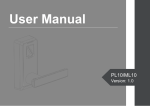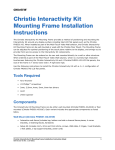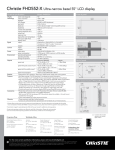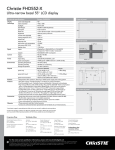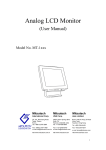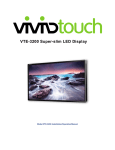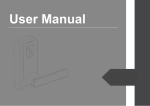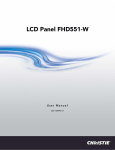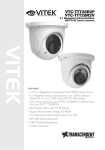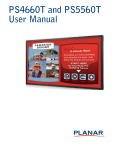Download Christie® FHD551-X | Technical FAQs
Transcript
® Christie FHD551-X Technical Frequently Asked Questions (FAQs) July 24, 2012 Index 1 Size and physical installation............................................................................................................ 3 1.1 1.2 1.3 1.4 1.5 1.6 1.7 2 Resolution and playback ................................................................................................................... 4 2.1 2.2 2.3 2.4 2.5 2.6 3 How many panels can be connected in one loop for control purposes? ...........................................5 What interfaces can be used to control the display?..............................................................................5 What is the Video Wall Toolbox software program? ..............................................................................6 What OSD languages are available?.......................................................................................................6 How do the panels get mapped so that a single source spans multiple panels? ............................6 Can the panels compensate for the 5.9mm gap between each display area? ................................6 Can the color and brightness of different panels be adjusted across the array? .............................6 What color temperatures are available? ................................................................................................6 Power and brightness ........................................................................................................................ 6 4.1 4.2 4.3 4.4 5 Can a single video signal be stretched across multiple panels? ........................................................4 Can an HDCP source be stretched across multiple panels? ..............................................................4 Does the panel support Picture-in-Picture mode? ................................................................................5 What is the panel refresh rate? ...............................................................................................................5 What is the panel response time?...........................................................................................................5 What timings are supported by the panel? ............................................................................................5 Control and calibration....................................................................................................................... 5 3.1 3.2 3.3 3.4 3.5 3.6 3.7 3.8 4 What is the maximum height and width of a tiled LCD display? ........................................................3 What mounting options are available from Christie? ...........................................................................3 How do you remove a panel that is surrounded by other panels? .....................................................3 How much room should I leave at the back for airflow? ......................................................................3 Can the panels be mounted in portrait orientation? .............................................................................4 Can the panels be mounted facing up or down? ..................................................................................4 Is the frame and pedestal structural solution self-supporting? ...........................................................4 What is the power consumption of the panel? ......................................................................................7 Is there a sleep function to turn off power during a period of inactivity? ...........................................7 How can the panel be woken from sleep mode? ..................................................................................7 Can the panels be programmed to turn on sequentially to minimize power surge on startup? .....7 Reliability ............................................................................................................................................. 7 5.1 5.2 5.3 5.4 5.5 What is the expected lifetime of the panel? ...........................................................................................7 What is the difference between image sticking and burn-in? .............................................................7 How can I reduce the risk of image retention? ......................................................................................8 How hard is it to damage the bezel or glass when handling the panel? ...........................................8 What are the reliability differences between consumer and commercial grade LCDs? .................8 Christie® FHD551-X | Technical FAQs | Revised July 24, 2012 ©2011 Christie Digital Systems USA, Inc. Page 2 FAQs 1 Size and physical installation 1.1 What is the maximum height and width of a tiled LCD display? The FHD551-X product can be installed up to six panels high with the mounting, frame and pedestal solutions provided by Christie. There is no practical restriction on the width of a display. 1.2 What mounting options are available from Christie? Christies provides two wall mounts, the ML10 for landscape orientation and the MP10 for portrait orientation. The mount design allows the cabling and controls behind each panel to be accessed without the disassembly of the video wall. A frame and pedestal structural solution, ideal for control rooms, is also available from Christie. In this solution, each wall mount is attached to a stackable frame, and each frame in the bottom row sits on a pedestal. Note: When using the pedestal and frame, additional hardware for tip resistance must be used. Refer to question 1.6 below for more details. For more information on how to install and mount an array of FHD551-X panels, including technical drawings of the frame and pedestal solution, refer to the User Manual and related downloads available at www.christiedigital.com 1.3 How do you remove a panel that is surrounded by other panels? Each mount has two latches that can be accessed from above or below. By pulling upwards on these latches, the mount can be pulled forwards and the panel accessed for servicing. To avoid damaging the LCD panel always release both latches at the same time and move the panel forwards evenly. If the latches cannot be reached, such as when a panel is surrounded by other panels, first release the panels either above or below it. 1.4 How much room should I leave at the back for airflow? When using the ML10 or MP10 mount available from Christie, this ensures a minimum distance of 79mm (3.1”) between the back of the panel and the wall. This distance is adequate so long as suitable airflow is provided to maintain the ambient temperature Christie® FHD551-X | Technical FAQs | Revised July 24, 2012 ©2011 Christie Digital Systems USA, Inc. Page 3 behind the panels below 40°C. Typically, cooling requirements increase as the height of the array increases. 1.5 Can the panels be mounted in portrait orientation? Yes. A portrait mount is available, model MP10. 1.6 Can the panels be mounted facing up or down? The FHD551-X product has been designed and tested for upright orientation only, either landscape or portrait. Downwards and upwards orientations are not covered under warranty. Mounting in a downwards facing orientation is a safety hazard due to the super narrow bezel. Mounting in an upwards facing orientation may result in sagging or mura defects over time, and has not been considered in the thermal design of the product. 1.7 Is the frame and pedestal structural solution self-supporting? The frame and pedestal solution provided by Christie is designed to bear the weight of the structure and panels. However, the structure must be secured to prevent tipping, either by tethering to the wall or the floor. Either use the rear tie points on the array or bolt the pedestal into the ground. Ensure that you provide adequate stability in the event that all panels are extended forward during assembly or servicing. 2 Resolution and playback 2.1 Can a single video signal be stretched across multiple panels? Yes. A DVI source can be stretched across a maximum of 9 panels and a VGA or composite source can be stretched across a maximum of 4 panels. For a DVI source, the maximum matrix dimensions are 3 wide by 3 high and for a VGA or composite source the maximum dimensions are 2 wide by 2 high. A DVI/VGA splitter may be used to distribute the video signal to support larger video wall configurations. Please note that the three video output connectors – DVI, VGA and composite – will only repeat the source that is connected to their matching input connectors. For instance, the DVI output repeats the video signal that is connected to the DVI input. If necessary, video adapters may be used to convert an input signal into the required connection type, e.g., HDMI to DVI. 2.2 Can an HDCP source be stretched across multiple panels? Yes, the FHD551-X panels support stretching HDCP content across multiple panels through daisy chaining the DVI connections, with the same limitations outlined in question 2.1 above. Christie® FHD551-X | Technical FAQs | Revised July 24, 2012 ©2011 Christie Digital Systems USA, Inc. Page 4 Due to the challenges in exchanging unique HDCP keys across multiple panels, many manufacturers do not support this feature. Instead, some manufacturers block HDCP content from being passed from one panel to another, thereby relying upon a front-end video processor to split up the HDCP content into separate input channels, while others pass unencrypted content from one panel to another in breach of HDCP rules. 2.3 Does the panel support Picture-in-Picture mode? Yes. Users can configure the size and position of PIP windows, as well as the source. 2.4 What is the panel refresh rate? 50/60 Hz. 2.5 What is the panel response time? 8 ms. 2.6 What timings are supported by the panel? Please refer to the back of the user manual for a complete table showing supported timings. 3 Control and calibration 3.1 How many panels can be connected in one loop for control purposes? Up to 25 panels can be controlled as a single array. Connect panels together using the RS485 inputs and outputs. Commonly available CAT5 cable may be used for the RS485 connections. 3.2 What interfaces can be used to control the display? There are two interfaces: the OSD and the serial command interface. The OSD can be accessed by connecting an IR receiver to one of the panels and pointing the IR remote at the receiver (receiver and remote are both supplied). Alternatively, the OSD can be accessed by pressing the control buttons located next to the input/output connectors on the side of the rear panel enclosure. Serial commands can be sent to a group of up to 25 panels through the RS232 input (see question 3.1 for limitation). Advanced users can send RS232 commands using a computer terminal or third party control panel. For convenience, a Video Wall Toolbox software program is available from Christie which provides access to all controls in a user friendly interface similar to the OSD (see question 3.3 below for more information on the Video Wall Toolbox). Christie® FHD551-X | Technical FAQs | Revised July 24, 2012 ©2011 Christie Digital Systems USA, Inc. Page 5 3.3 What is the Video Wall Toolbox software program? The Video Wall Toolbox is a Windows-based software program that enables you to control up to 25 panels from a separate computer through an RS232 connection to the wall. Through the Toolbox application, all display parameters can be controlled for an individual panel or multiple panels within the video wall. In addition, the application supports an Auto Setup feature, which automatically configures display ID, matrix size and positions for each panel within a single source video wall. To download the Video Wall Toolbox, visit www.christiedigital.com In order for the Auto Setup feature to work, all panels must be connected according to the recommended RS485 cabling scheme. Refer to the online User Manual or the Toolbox application for more details. 3.4 What OSD languages are available? English / Chinese (simplified) / French / German / Italian / Portuguese / Russian / Spanish. 3.5 How do the panels get mapped so that a single source spans multiple panels? Each panel can be mapped using the OSD or the Video Wall Toolbox. In a simple installation where a single source is being displayed across multiple panels, for instance a DVI source is being spanned across a 3x3 array, the Auto Setup feature in the Video Wall Toolbox will map all the panels for you (see question 3.3 above). 3.6 Can the panels compensate for the 5.9mm gap between each display area? Yes. The bezel compensation feature slightly crops the image on each panel for maximum continuity of images that span multiple panels. 3.7 Can the color and brightness of different panels be adjusted across the array? The user may adjust brightness and RGB gain and offset values on each panel to help match color and brightness across the array. On large arrays, this may be a time consuming process. 3.8 What color temperatures are available? The user can adjust the color temperature manually, or select from 3200K, 5400K, 6500K, 7500K, 9300K and 9600K. However, the brightness of the panels is lower at warmer color temperatures, due to the higher proportion of the blue wavelength in the LED backlight. This is a fundamental limitation shared by all LED backlit LCD panels on the market today. 4 Power and brightness Christie® FHD551-X | Technical FAQs | Revised July 24, 2012 ©2011 Christie Digital Systems USA, Inc. Page 6 4.1 What is the power consumption of the panel? Typical operating power consumption is 175W at 80% backlight (factory default), 210W at 100% backlight, and the design maximum is 275W. 4.2 Is there a sleep function to turn off power during a period of inactivity? Yes, an optional sleep mode is available. The user can select one of five timeout periods between 15 and 120 minutes. 4.3 How can the panel be woken from sleep mode? When in sleep mode, the panel can be woken through the IR remote, an active VGA signal, or an RS-232 command. In order to restrict power consumption during sleep mode to ≤1W, an active DVI source will not wake the panel. 4.4 Can the panels be programmed to turn on sequentially to minimize power surge on startup? Yes, the user can program panels to turn on sequentially across a total period of up to 30 seconds. 5 Reliability 5.1 What is the expected lifetime of the panel? Each component of the panel is long-lasting and reliable. The solid state LED backlight is rated by the manufacturer for 50,000 hours of operation. Ultimately, when a component needs repairing or replacing, each display unit contains three serviceable parts – power supply, electronics and fan – which can be changed in less than 15 minutes with the panel laying face-down on a flat surface. 5.2 What is the difference between image sticking and burn-in? If a static image is displayed continuously on an LCD panel for an extended period of time, a faint remnant of the image may be visible on the panel even when a different image is displayed. This is commonly referred to as “image sticking”. Image sticking can be reversed by resting the panel. If static images are allowed to persist on a panel for much longer periods of time, “burn-in” may occur. Burn-in looks similar to image-sticking, except it permanently damages the panel and cannot be reversed. Both image sticking and burn-in may be referred to as forms of “image retention”. Christie® FHD551-X | Technical FAQs | Revised July 24, 2012 ©2011 Christie Digital Systems USA, Inc. Page 7 5.3 How can I reduce the risk of image retention? Turning off or using power management for 4 hours per day will extend the life of the product and minimize the risk of image retention. In circumstances where a static image must be displayed over long periods of time, activating the Image Retention Frame Motion (IRFM) feature will help to avoid image retention (refer to section 2.3.7). 5.4 How hard is it to damage the bezel or glass when handling the panel? Design features in the packaging and the panel have been included to minimize the risk of damage. Even so, the small size of the bezel, which is essential in order to achieve minimal image-to-image gaps, means that there is reduced protection of the LCD glass and components around its perimeter. Dropping the panel or applying unnecessary force to the sides of the bezel will result in permanent damage. Consequently, only trained technical staff should handle the product, and proper care must be taken to follow the unpacking, handling, assembly and servicing instructions provided online at www.christiedigital.com and in the box. For unpacking, handling, mounting and servicing instructions, visit www.christiedigital.com 5.5 What are the reliability differences between consumer and commercial grade LCDs? Consumer grade LCD panels are designed to operate for much shorter periods of time, are more prone to burn-in, cannot be mounted in portrait orientation, are lower brightness, have shorter product lifecycles, and are more reflective in well lit environments. Christie® FHD551-X | Technical FAQs | Revised July 24, 2012 ©2011 Christie Digital Systems USA, Inc. Page 8








